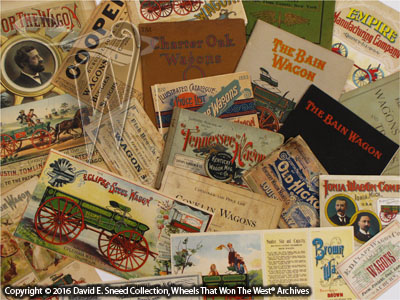As America moved West in the 1800’s, there were numerous routes andtrails that the explorers, traders, prospectors, cowboys, immigrants, and somany others followed. Legendary routeslike the Oregon, California, Santa Fe, Chisolm, Bozeman, Western, and Goodnight-LovingTrail have all rightly garnered their share of attention. Even so, as committed to research as we’vebeen, the trail we end up following a good part of the time is a bitdifferent. It’s called, the ‘Paper Trail.’
Twenty-one years ago, it was a bit of a pipe dream to believe that anyonecould assemble enough scattered files from an all-but-forgotten industry to addmuch to our knowledge of wagons and western vehicles. And ‘yes,’ I still have folks tell me thesame thing... that the subject isn’t worth pursuing, isn’t interesting enough,or even the coup de grâce ofdiscouragement – “There’s already sufficient research andknowledge about wagons and western vehicles.” I’ll admit these are comments that I don’t really understand. After all, as a historian involved in thisstudy for more than two decades, there is one thing I know for certain... withall we think we know, America has only begun to learn about this industry, itsvehicles, stories, and the values associated with each.
Perhaps it’s too big of a stretch to believe we can uncover andpreserve all of what might still exist. Then again, why wouldn’t we try? After all, a lack of knowledge is what has allowed too many historicpieces to drift into oblivion. Don’tbelieve me? Have you ever seen a wagonwhose maker you couldn’t identify? Howmany of those unknown vehicles might have been a 19th century powerhouse brandlike Murphy, Caldwell, Kansas, Espenshied, Jackson, LaBelle, or other set ofwheels highly desired in the West? These were just some of the renowned names thathelped open the frontier and, incredibly, there are none of these 19th centurypieces conclusively identified today. Hundreds of thousands of these particular vehicles are gone. So, how can we tell the complete history ofthe legendary trails in the West without at least one of them? The answer seems clear, which helps explainthe urgency in tracking down so much history. The vast majority of America’s surviving wood-wheeled wagons were builtin the 20th century. So, how do wedetermine the evolutionary differences and how can we categorize them withinthe individual brands? In a nutshell,that’s why we began an earnest study of this part of America’s heritage so longago. It’s allowed us to separate a greatdeal of fact from fiction and unsubstantiated claims from actual history.
 |
| This image shows a small sampling of original catalogs and promotional materials in the Wheels That Won The West® Archives. |
Even so, tenacity has a way of accomplishing what often seemsfruitless. We see it in the effects of time, wind, and water wearing down solid rock, creatingthe Divine masterpiece we know as America’s Grand Canyon. Persistence has always had a way of delivering great things. The diligence it manifests has allowed us touncover near countless trails to our past. In several circumstances, the materials we’ve come across were just daysaway from being destroyed. Clearly,history doesn’t seem to be overly important to everyone. It’s interesting to note, though, that someof the world’s best marketers and advertisers are students of history. They work hard to uncover past consumerhabits in an effort to better predict future behavior. It’s one of the reasons why bread and milkare typically located in the back of the store and not the front, why certainshelf space is more valuable than others, and the understanding that, given anequal choice, most folks will go to the right side of a store first. This research may be called a lot of thingsbut, make no mistake; it’s the study of history as much as anything else. In a similar way, our nation’s firsttransportation industry offers insights that help us see and appreciate ourentrepreneurial, free market roots in a more responsible way.
Week in and week out, our own determined study is punctuated bycountless discoveries. The process hasgiven us rare gifts of original materials produced by legendary St. Louisbuilder, Joseph Murphy. Likewise, we’ve been able to securepreviously unknown records outlining exact paint specifications for 1870’s–eraStudebaker wagons. We’ve stumbled uponthe only known photograph of a legendary Caldwell/Kansas wagon and acquiredthrough-the-years visuals documenting the changing look of Weber, Mitchell,Bain, Fish Bros., and so many more vehicles dominating the Old West. Recently, we’ve also been fortunate to pindown a number of obscure facts related to the operations of both J. StephensAbbot and Louis Downing during the years when these legendary coach makers wereseparated (1847 – 1865). These kinds ofdetails can be crucial when evaluating a specific vehicle’s identification andauthenticity levels.
Ultimately, the same pitfalls don’t generally lie in wait for us as they did for those headed west in the 1800’s. There are other challenges, though. There are long, dry spells of findingnothing. There are dead-ends in search directions that prevent us from moving forward. Equally taxing are issues with transportation as we travel for research. And then, there's the ever presentmental voice asking, ‘Are you crazy for doing this?’ I may already know the answer to that lastone. Even so, the stories anddiscoveries continue to draw me in. Inthe end, the old trails of the West allow us to feel a connection to who we areas a people while the ‘Paper Trail’ helps us better understand how we gotthere.
Please Note: As with each of our blog writings, all imagery and text is copyrighted with All Rights Reserved. The material may not be broadcast, published, rewritten, or redistributed without prior written permission from David E. Sneed, Wheels That Won The West® Archives.
